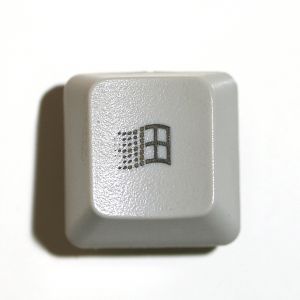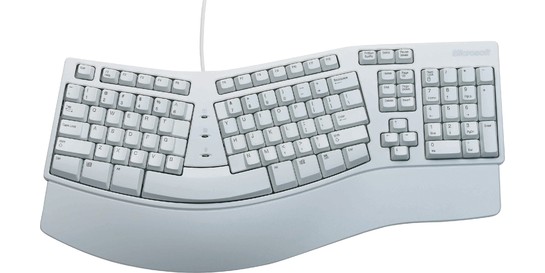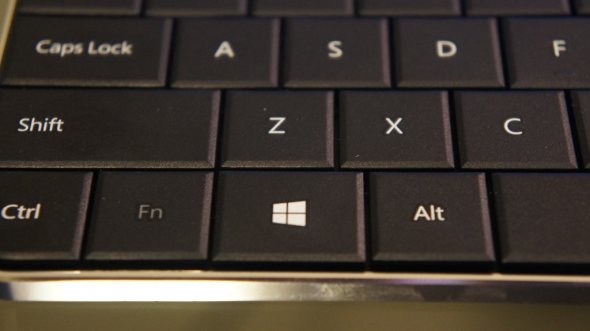-
-
products
-
resources
-
support
-
company
-
The Windows Key: Everything You Ever Wanted to Know
By Steve Horton November 20, 2012Windows 7, windows 8, windows key, windows vista, Windows XPNo CommentsIf you’ve used a PC for a long time, you’d know that the PC keyboard underwent a radical shift over 15 years ago, and has stayed the same ever since. Around 1995, it gained three new keys: a pair of Windows Keys and a Menu Key. (On some laptops, the extra key is missing.) We’re going to talk about the first one, the Windows Key. Where it came from, what it does, and how you can use it to get around Windows more easily.

This is how the Windows Key looked originally.History of the Windows Key
The Windows Key first appeared in advance of the release of Windows 95 on the Microsoft Natural Keyboard. Remember that split level keyboard intended to reduce stress injuries that was nearly impossible to type on? Soon after the release of Win 95, this key started appearing on keyboards and laptops everywhere. The logo on the key has even changed numerous times to match the logo found on the current version of Windows. Even the Microsoft Surface tablet has a hardware Windows home screen button that mimics the functionality of the Windows Key.

The Natural Keyboard is where the Windows Key first appeared.What Does the Windows Key Do?
In all versions of Windows from Windows 95 through Windows 7, tapping this key brings up the Start Menu. It’s a really useful way to get into that menu without having to move the mouse to the lower left corner and click Start.
In Windows 8, tapping the Windows Key from the Desktop takes you to the Start Screen. Tapping the same key from the Start Screen takes you back to the desktop.

The Windows Key logo now matches Windows 8.What are Some Windows Key Shortcuts?
Here are a few really handy keyboard shortcuts that include the Windows Key.
Windows XP or Later
Windows Key + D: Clear all the windows and show the Windows Desktop. If pressed while on the Windows 8 Start Screen, though, it has the same effect as pressing the Windows Key from there.
Windows Key + F: Search for files. Later versions of Windows perform searches much more quickly than earlier versions.
Windows Key + L: Lock the desktop. If Windows is password protected, it’ll ask for the password to get out of the lock screen.
Windows Vista or Later
Windows Key + Tab: Aero Flip. (Does not work in Windows 8.) This is a 3D app-switching tool that’s much flashier but not much more useful than Alt + Tab.
Windows Key + a Number: Launch a program from the Taskbar. Windows Key + 1 runs the leftmost program and Windows Key + 0 runs the tenth from the left. If the app is already open, this shortcut will switch to it.
Windows 7 or Later
Windows Key + T to cycle through items in the taskbar, from left to right.
Windows Key + Arrow Key to perform Aero Snap. Up Arrow maximizes the window. Left Arrow snaps it to the left half of the screen, Right Arrow snaps it to the right side of the screen, and Down Arrow miminizes it.
Windows 8 Only
Windows Key + C to open the Charms Bar on the right side of the screen.
Windows Key + X to bring up the Power User Menu, giving you many of the functions lost with the missing Start Menu, such as access to the Control Panel, Run Dialog and Command Prompt.
What if I Don’t Have a Windows Key?
There may be cases where you have an old keyboard lying around — likely a serial, rather than USB keyboard — or you’re using a wireless keyboard designed for another operating system. In that case, pressing Ctrl + Esc will give you some of the same functionality as pressing the Windows Key. However, you can’t combine Ctrl + Esc and any other keys to activate Windows Key Shortcuts. Ctrl + Esc is only good for getting into the Start Menu or Start Screen.
Use the Windows Key
Like me, you may find clicking Start more natural than pressing a key on the keyboard that you’re still not used to. However, it’s a good idea to become familiar with the Windows Key and all its uses. If you ever upgrade to Windows 8, for example, this key is absolutely essential for getting around. Even if you don’t, the keyboard shortcuts alone will save you a lot of time.
Was this post helpful?YesNoFree Driver Updates
Update your drivers in less than 2 minutes to enjoy better PC performance - Free.
Free Driver Updates
Update your drivers in less than 2 minutes to enjoy better
PC performance - Free.
Didn't find your answer?Ask a question to our community of experts from around the world and receive an answer in no time at all.most relevant recent articles Pin It on Pinterest